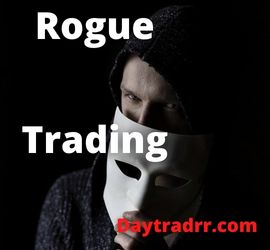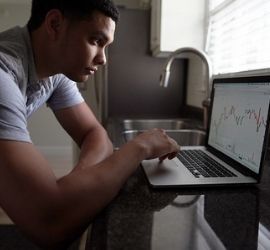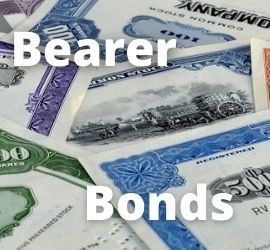What Is Rogue Trading?
 Rogue trading is the practice of trading securities using another person or institution’s accounts and money without proper approval or oversight.
Rogue trading is the practice of trading securities using another person or institution’s accounts and money without proper approval or oversight.
What is a Rogue Trader?
A rogue trader is a trader who behaves recklessly and without regard for authority or rules. Their actions can ultimately be to the disadvantage of the institution that employs the trader – and possibly their clients. Rogue traders often engage in high-risk investments. When successful, the payoff can be enormous. However, when unsuccessful, the losses can be equally substantial.
Rogue traders are only labeled as such if they lose. No one considers them “rogue” if their deals are extremely profitable. In fact, stellar traders are rewarded, often with a large bonus. However, if these are risky bets and the trader loses, they run a greater risk of being labeled as rogue. Risky deals have the potential to cost the company millions, if not billions, of dollars in losses.
Rogue Trading – A Closer Look
Banks create sophisticated Value-at-Risk (VaR) models to manage the trading of instruments. These models determine which desks may trade, when they can trade, and how much they can trade in a particular period. The trade limit, in particular, is carefully set and monitored. Not only is this to safeguard the bank but also to satisfy regulators. However, internal controls are not completely failsafe. A diligent trader can find a way to work around the system in order to earn large profits. Frequently, they are caught in improper trades and then forced by regulators to be publicly revealed – to the bank’s disgrace.
There have been massive financial losses and bankruptcies throughout the banking industry as a result of internal trading losses. Most are attributed as simply bad decisions by senior decision-makers in these financial institutions. For example, the bankruptcy of Lehman Brothers necessitated the 2008 United Kingdom bank rescue package. However, this was not considered rogue trading or fraud and was therefore not punishable in a criminal action.
Even if the investment bank does not go bankrupt, the institution may still attempt to conceal what the rogue trader did. Disclosure would tarnish the investment bank’s reputation, frightening away both investors and clients. However, this type of corporate cover-up is a form of fraud in and of itself. It can land the investment bank in serious difficulty with the Securities and Exchange Commission (SEC). In addition, the lax internal controls that permitted the rogue trade to occur may be sanctionable.
Rogue Trading Isn’t Always Intentional
Most rogue traders never intended to trade outside the rules. Many prominent traders admit that they might occasionally conduct a terrible transaction that costs the bank a lot of money. Fearing for their job, the trader then engages in increasingly dangerous trades in an attempt to recoup the losses. Sometimes, they are able to correct the shortfall and resume normal trading activities. Sometimes, however, the trades spin out of control and even more money is lost. The point at which a trader has “gone rogue” is when they falsify their trading activity and hide the losses to buy more time. Rogue traders can cost their employers so much money that the institution goes bankrupt.
Examples of Rogue Trading
Barings Bank – £827m 1992
Nick Leeson was a former derivatives trader at Britain’s Barings Bank’s Singapore headquarters. He is one of the most renowned rogue traders in recent years. Leeson suffered significant losses in 1995 as a result of unlawful trading of Nikkei futures and options. Leeson used the Nikkei to take massive derivative positions that leveraged the amount of money at stake in the trades. At one point, Leeson held 20,000 Nikkei futures contracts worth more than $3 billion. The fall in the Nikkei following a big earthquake in Japan produced a broad-based sell-off in the Nikkei. A single week accounted for a large portion of the losses. The total loss to the 233-year-old Barings Bank was well over $1 billion. This ultimately led to the bank’s insolvency. Leeson was accused of fraud and sentenced to several years in prison in Singapore.
Société Générale – £3.7bn 2008
In January 2008, SocGen announced that a rogue trader had cost the bank £3.7 billion. The trader was identified as Jérôme Kerviel. He had been holding unauthorized positions on stock futures, according to the bank. A subsequent court action revealed that Kerviel had gambled €50 billion of the bank’s money on the trades. Kerviel said that the bank had turned a blind eye when his trades were profitable. Kerviel worked in compliance, and bank executives said he was skilled at concealing his losses and avoiding checks.
Sumitomo Corporation – $2.6bn 1987-1997
Yasuo Hamanaka, the King of Copper, was sentenced to eight years in prison for fraud and forgery in 1997. This was after he was discovered to have engaged in rogue trading and fraud for more than a decade. Hamanaka claimed to control 5% of the global copper market at the height of his authority. His off-the-books deals drove up prices and earned big profits for years. However, the scandal eventually cost Sumitomo $2.6 billion. Sumitomo paid roughly $150 million to settle accusations from British and US regulators a year after Hamanaka’s sentencing.
Daiwa Bank – $1.1bn
Toshihide Iguchi admitted in a 30-page letter that he had lost $1.1 billion through unlawful bond trading. Iguchi was a senior executive in Daiwa’s United States bank operations. Toshi rose through the ranks to become a trader in 1984. A lack of segregation within his sector allowed him to conceal his losses from his superiors. For over a decade, Iguchi attempted and failed, to trade back to profit. During that time, he admitted he fabricated around 30,000 trading slips. At one point, he was regarded as the department’s golden boy. However, in 1996 he was sentenced to four years in prison and fined $2.6 million. Daiwa was also sharply penalized. The Federal Reserve ordered it to cease all operations in the United States. The Fed order resulted in the sale of the majority of Daiwa’s US assets in January 2006.
(Source: theguardian.com & investopedia.com)
Up Next: Ancillary Health Insurance
 Ancillary Health Insurance adds supplemental coverage or extends the coverage you already have for expenses that often accompany many medical treatments. This coverage also refers to benefits that are used to supplement group health insurance. These can include highly sought-after employee benefits like dental, vision, and life insurance.
Ancillary Health Insurance adds supplemental coverage or extends the coverage you already have for expenses that often accompany many medical treatments. This coverage also refers to benefits that are used to supplement group health insurance. These can include highly sought-after employee benefits like dental, vision, and life insurance.
Ancillary benefits provide secondary health insurance coverage that covers miscellaneous medical expenses. These additional benefits can protect you from unexpected expenses that can be incurred during hospital stays. In other words, they can cover additional or related expenses such as ambulance transportation, blood, drugs, and medical supplies like bandages. These benefits are usually layered on top of major medical coverage so they are purchased through the same policy and insurance carrier.




